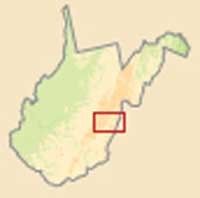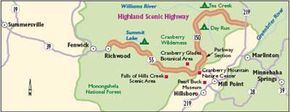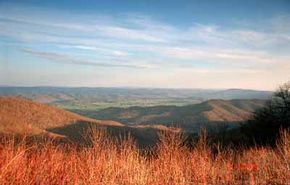Travel through a wild and undeveloped portion of the Monongahela National Forest on the Highland Scenic Highway in West Virginia. See rolling, mountainous terrain covered by hardwood forests and capped by dark spruce at higher elevations from one of four overlooks. This view is one you won't want to miss. Hidden within this panoramic view, you'll find plenty of places to visit and things to do.
Cultural Qualities of the Highland Scenic Highway
As an isolated area with abundant natural resources, the wilderness of the Highland Scenic Highway was an early haven for Americans seeking to avoid the horrors of the Civil War. Families who moved to the area at this time maintained their seclusion for decades.
Advertisement

In the 1960s, the descendants of these families experienced a visit from people researching for the Smithsonian Institution. As the researchers studied and recorded the oral histories of the families in this area, they discovered that the language spoken was still the Elizabethan English of the early U.S. settlers. Tradition and folk tales of the area have been recorded and are a remnant of the mountain cultures of the East.
Historical Qualities of the Highland Scenic Highway
There are many historical events associated with the Highland Scenic Highway. As intensive logging developed along this road, so did the habitation of the area. In the early 1900s, logging of almost all the timber in the area was done. Due to the lack of transportation possibilities into the area, the land surrounding the Highland Scenic Highway remained relatively unsettled for decades.
However, once the area was recognized as a resource, it was not long before a logging culture established there. Remainders of these logging times along the Highland Scenic Highway can still be found today. For example, the Tea Creek Campground was constructed on the site of an old logging camp.
Another important historical event that occurred along this byway was the birth of a famous author Pearl S. Buck in Hillsboro.
A darker time in the history of the byway occurred during World War II. East of Cranberry Glades is the site of the former World War II Mill Point Prison Camp. This camp housed federal prisoners of the time, conscientious objectors, and moonshiners.
Natural Qualities of the Highland Scenic Highway
This region has a great deal to offer in the way of natural phenomena. The byway meanders through the Monongahela National Forest. Part of the byway follows the Williams River as it entices anglers to test their skill.
A region of 750 acres that the Highland Scenic Highway encompasses is rich in acidic wetlands known as bogs. The largest of these wetlands is the Cranberry Glades Botanical Area. It consists of four bogs that are home to some unusual species of plants and animals.
The spongy ground of the bog is made up of partially decayed plant material known best as peat. Five species of birds, carnivorous plants, and a species of bog orchids can be found in the Cranberry Glades area. A half-mile boardwalk has been constructed through two of the bogs for visitors to explore the area without disturbing the fragile ecosystem. This forest-covered land was acquired by the U.S. Forest Service in 1934. Since then, it has been a prized area of West Virginia where rivers, mountains, and trees form a spectacular outdoor experience. Several trails wind throughout the area where visitors can travel the wilderness on foot.
The gorge that holds three waterfalls known as the Falls of Hills Creek includes geological points of interest as well as a wide range of plant life. The falls were formed from the unstable layering of shale and sandstone. This layering is exposed to add to the natural beauty of the area. The Hills Creek area is also well known for its abundance of wildflowers in the spring.
As visitors hike through the Monongahela National Forest, they may stumble onto natural treasures and views untold. Just recently, unusual honeycomb rock formations were found very near to the byway.
Recreational Qualities of the Highland Scenic Highway
The Highland Scenic Highway area offers recreational opportunities for travelers who enjoy hunting, fishing, hiking, or camping. For example, along the Cherry, Cranberry, and Williams Rivers, you'll find anglers casting for trout. The West Virginia Division of Natural Resources stocks the streams with rainbow, brook, brown, and golden trout. Summit Lake, a beautiful 42-acre reservoir, contains trout, bass, and panfish. Boats with electric trolling motors are allowed on the lake. Hunting is available in the Monongahela National Forest in accordance with West Virginia state regulations.
More than 150 miles of trails are located in the area of the Highland Scenic Highway. The Falls of Hills Creek Scenic Area, the Cranberry Glades, and the Big Spruce Overlook offer three barrier-free trails. For those interested in a backpacking experience, Cranberry Wilderness and the Tea Creek area offer places for camping. Visitors should camp away from trails and streams. Many trails in the area also offer opportunities for horseback riding and are suitable for cross-country skiing in the winter. Mountain biking is permitted on most of the trails located outside of the Cranberry Wilderness.
Three campgrounds are included in the Highland Scenic Highway area. If a stay by the lake sounds appealing, Summit Lake Campground is two miles from State Route 39/55. For campsites by the Williams River, Tea Creek Campground is one mile from the parkway portion of the byway, and Day Run Campground is only four miles away.
Find more useful information related to West Virginia's Highland Scenic Highway:
- West Virginia Scenic Drives: The Highland Scenic Highway is just one of the scenic byways in West Virginia. Check out the others.
- How to Drive Economically: Fuel economy is a major concern when you're on a driving trip. Learn how to get better gas mileage.
Advertisement













